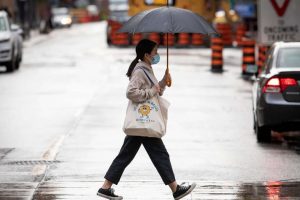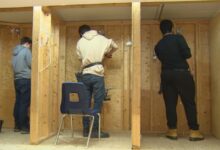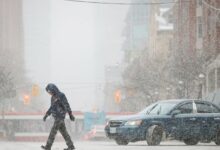Ontario sees 783 new COVID-19 cases with ‘concerning’ rise in York Region

Ontario reported an additional 783 cases of COVID-19 on Thursday, with what Premier Doug Ford called a “concerning” number of new infections in York Region.
At a news conference Thursday, Ford told reporters his government is meeting with its health table later today, where they will look into the situation in York Region, where new COVID-19 numbers climbed past those of Ottawa.
Ottawa is one of three hotspots along with Toronto and Peel Region where the province introduced modified Stage 2 restrictions nearly a week ago.
“York’s teetering right now,” said Ford. “We’re keeping a very close eye on York right now … It’s concerning.”
Ford was also asked about people moving from areas where modified Stage 2 closures are in place to areas not under the same restrictions, such as to visit gyms.
The premier urged people to “try to work out at home” and did not rule out action if COVID-19 appears to spike in those areas.
“That’s going to only add to our numbers and add to the problem,” said Health Minister Christine Elliott.
Province no longer aiming to balance budget by 2022
Ford, joined by treasury board president Peter Bethanfalvy, also took questions about the state of the province’s finances amid new projections from the province’s financial accountability officer that show Ontario is facing a budget deficit of $37.2 billion for 2020-21.
Asked if the province still intends to balance its budget by 2022, Bethanfalvy said the pandemic has changed that goal, with the aim now to balance the budget “over a number of years.”
“We’re going to make sure that we take, first and foremost, the safety and the health of all Ontarians,” he said.
Bethanfalvy added the provincial government has to file a budget by Nov. 15 and is working toward that.
York Region sees record-high cases
The newly confirmed infections in Thursday’s update were again mainly concentrated in four public health units:
- Toronto: 239
- Peel Region: 136
- York Region: 127 (A new record-high for the area)
- Ottawa: 89
Ontario saw almost as many newly resolved cases as new ones, as the number of outbreaks in long-term care settings also continued to rise.
Toronto has consistently seen the most new daily cases throughout the pandemic, however Ottawa currently has the worst per-capita rate of COVID-19 cases in the province, according to Public Health Ontario officials.
Other public health units that logged double-digit increases in new cases of the illness include:
- Durham Region: 40
- Halton Region: 28
- Eastern Ontario: 23
- Hamilton: 19
- Niagara Region: 19
- Simcoe Muskoka: 15
- Waterloo Region: 13
- Brant County: 12
Thursday marks the first in more than a week that the seven-day average of new daily cases has decreased, moving from about 781 yesterday to 779 today, though it has been trending consistently upward since a low in mid-August.
Some 109 of the new cases in today’s provincial report are school-related, including 55 students, 17 staff and 37 people who were not identified as either. There have been 1,145 cases connected to schools across Ontario since the academic year began.
A total of 451 of the province’s 4,828 publicly-funded schools, or about 9.34 per cent, have reported at least one case of COVID-19. Five schools are currently closed due to the illness.
Meanwhile, the province’s labs processed 39,9612 tests, a notable increase over yesterday’s figure but still well below the mid-October target of 50,000 per day set by the health ministry last month.
Some 26,558 samples are still in the queue waiting to be completed, meaning that more than 49,700 tests were taken since the last update — possibly an indication that overall testing levels are rebounding after Ontario shifted to an appointment-only system.
The number of patients in Ontario hospitals with confirmed cases of COVID-19 took a relatively steep jump, increasing by 22 to 253. However both the number of people being treated in intensive care units and with ventilators both fell slightly, by two and four, respectively, and now sit at 62 and 31.
The province’s death toll from the illness grew by five and is now 3,022.
Further, there are currently 71 outbreaks of the novel coronavirus in long-term care facilities, up six from the last update and a figure not seen since early June.
On Wednesday, the province announced that long-term care residents in Toronto, Peel and Ottawa won’t be allowed to go out for social or personal reasons as of Friday. Short-term and temporary absences for medical or compassionate reasons, however, will still be allowed.
There have been a total of 62,196 confirmed cases of the novel coronavirus in Ontario since the outbreak began in late January. Of those, 53,291 are considered resolved, including 779 in today’s report.
There are currently some 5,883 confirmed, active cases of COVID-19 provincewide, down from the record-high of 5,946 but still more than at any point in the spring.
All of the figures used in this story are found in the Ministry of Health’s daily update, which includes data from up until 4 p.m. the previous day. The number of cases for any particular region on a given day may differ from what is reported by the local public health unit, which often avoid lag times in the provincial system.
Province revokes seniority rule for teacher hiring
Premier Doug Ford’s government is temporarily revoking a policy that for the past decade has forced Ontario school boards to hire only from a pool of teachers with the most seniority.
The hiring rule “rewards union seniority over one’s merit,” Education Minister Stephen Lecce said Thursday in announcing the province’s move to repeal the policy, known as Regulation 274.
The revocation is being triggered by hiring delays experienced by school boards this fall as they responded to the staffing changes brought about by the COVID-19 pandemic, said Lecce. While he characterized the move as temporary, he did not give a timeframe for putting the rule back in place.
Some school boards have suggested the rule makes it harder for younger applicants straight out of their education degree to break into the system and constrains boards from diversifying the teaching workforce.








Redes Sociais - Comentários